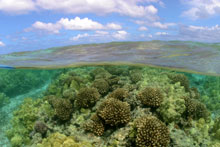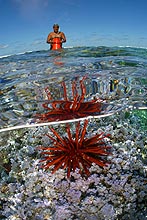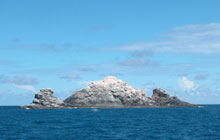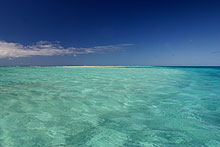NOWRAMP
2002
Put
Your Face Where Your Feet Are!
Posted
by Dr. Larry Basch, Senior Scientist-Advisor, Pacific Islands
Coral Reef Program, National Park Service, & Associate
Professor, Graduate Program in Ecology, Evolution &
Conservation Biology, University of Hawai'i at Manoa.
October 22, 2002
 At
the dawn of tank diving an eminent and wise marine biologist-professor,
Don Abbott, husband of Tutu Izzie, said to his students
- my mentors - who wanted to dive in pursuit of their research
that there are lifetimes of work and study still left to
do in the intertidal zone, that narrow and stressful yet
magical band of shore at times washed by the waves and at
others exposed to the air, and the heat and ultraviolet
rays of the sun. Fifty years and many research tank dives
later by his academic progeny and other successors, we've
learned lifetimes about the world beneath the waves. Nowadays
it's so relatively easy to put on a tank to dive and study
the biology, geology, or ecology of coral reefs and other
subtidal benthic ecosystems. During this era in the islands
of Hawai'i nei the intertidal has gotten pretty short shrift,
little attention has been paid to it, reflected today by
there being only two marine biology students out of hundreds
in Hawai'i whose research focuses on intertidal ecology.
At
the dawn of tank diving an eminent and wise marine biologist-professor,
Don Abbott, husband of Tutu Izzie, said to his students
- my mentors - who wanted to dive in pursuit of their research
that there are lifetimes of work and study still left to
do in the intertidal zone, that narrow and stressful yet
magical band of shore at times washed by the waves and at
others exposed to the air, and the heat and ultraviolet
rays of the sun. Fifty years and many research tank dives
later by his academic progeny and other successors, we've
learned lifetimes about the world beneath the waves. Nowadays
it's so relatively easy to put on a tank to dive and study
the biology, geology, or ecology of coral reefs and other
subtidal benthic ecosystems. During this era in the islands
of Hawai'i nei the intertidal has gotten pretty short shrift,
little attention has been paid to it, reflected today by
there being only two marine biology students out of hundreds
in Hawai'i whose research focuses on intertidal ecology.
 Leading
up to this expedition I enjoyed meeting weekly with others
on the RAT - Research Advisory Team, planning the scientific
research and integrating it with cultural and educational
efforts for NOWRAMP 2002. I was originally asked to be an
REA - Coral Reef Rapid Ecological Assessment -- team member,
responsible for collecting data on marine invertebrates,
one of my intellectual passions. I was really looking forward
to diving and doing subtidal ecology in the NWHI - an opportunity
of a lifetime! But, for a bureaucratic reason I wasn't able
to strap a tank on my back and go to work as usual. Getting
past the questions and comments of many mystified colleagues
(like: that's BS; what do you mean you've done 1000's of
dives, you're a dive instructor; trained many, including
some aboard this expedition…) and my own initial disappointment
wasn't easy… until we reached our first island in the
Northwest chain - Nihoa! Shortly after we landed but before
the chants by our Kanaka Maoli shipmates were over,
I began to realize the incredible nature of the world between
the tides that we were now standing in and about to explore.
And it dawned on me that despite some earlier natural history
explorations that we, Jeremy Polloi- team limu-ologist and
the other half of the intertidal duo - were going to be
breaking new ground at every island, atoll and shallow reef
flat we traveled to!
Leading
up to this expedition I enjoyed meeting weekly with others
on the RAT - Research Advisory Team, planning the scientific
research and integrating it with cultural and educational
efforts for NOWRAMP 2002. I was originally asked to be an
REA - Coral Reef Rapid Ecological Assessment -- team member,
responsible for collecting data on marine invertebrates,
one of my intellectual passions. I was really looking forward
to diving and doing subtidal ecology in the NWHI - an opportunity
of a lifetime! But, for a bureaucratic reason I wasn't able
to strap a tank on my back and go to work as usual. Getting
past the questions and comments of many mystified colleagues
(like: that's BS; what do you mean you've done 1000's of
dives, you're a dive instructor; trained many, including
some aboard this expedition…) and my own initial disappointment
wasn't easy… until we reached our first island in the
Northwest chain - Nihoa! Shortly after we landed but before
the chants by our Kanaka Maoli shipmates were over,
I began to realize the incredible nature of the world between
the tides that we were now standing in and about to explore.
And it dawned on me that despite some earlier natural history
explorations that we, Jeremy Polloi- team limu-ologist and
the other half of the intertidal duo - were going to be
breaking new ground at every island, atoll and shallow reef
flat we traveled to!
 Up
till now there's been little work done in the intertidal
of the NWHI other than collection of specimens and some
good "19th century" natural history. Now, there's
nothing bad whatsoever about natural history - it's key
to any meaningful rigorous ecological study. It's also fun!
Our goal was to add to that earlier knowledge. So we packed
our transect tapes and quadrats, sample bags and calipers
ready to get data - numbers - on sizes, abundance, distribution,
densities, and whatever else we could find about critters
and limu in the shallows. That's when reality came crashing
down, literally. The waves, many - way -overhead, smashing
onto the rocks were enough to make the most hard-stuck opihi
shudder. And much of the intertidal shore's rock faces were
shear vertical walls, dropping off into deep water. So,
it was pretty much impossible to lay meter tapes or put
down quadrats. Uh, time for plan B. Between huge sets we
looked or scrambled down to the mid- and low-intertidal
like 'A'ama crabs and picked up a critter here and
a clump of limu there. In most places this was all we could
do, spotting each other and the incoming waves as we moved
along the shore. On a few islands we were able to lay quadrats
down and get out our calipers to count and measure opihi.
And there are some tutu opihi out there, bigger than we've
seen living on the populated "lower" islands.
Recalling that many opihi pickers are killed every year
we were careful, wore life jackets, spotted and belayed
each other, trying to not bus-up our head. Now and then
a big set would wash over the opihi and us. One day, working
our way around to the windward side of Gardner
Pinnacle measuring opihi, a big sneaker wave came through.
All of a sudden I was surrounded by fast moving water --
lots of it -- and heard Jeremy calling out my name. I remember
putting one hand on top of my head while sliding down the
limu-covered rock 20 feet or so on my back and okole, totally
awash under the receding wave, then facing the rock, spinning
around and swimming hard away from shore before the next
big swell smashed into the rock. I turned around and gave
Jeremy the OK sign, then swam to safety, another near life
experience. Better than any water park attraction, if you
have a tough okole.
Up
till now there's been little work done in the intertidal
of the NWHI other than collection of specimens and some
good "19th century" natural history. Now, there's
nothing bad whatsoever about natural history - it's key
to any meaningful rigorous ecological study. It's also fun!
Our goal was to add to that earlier knowledge. So we packed
our transect tapes and quadrats, sample bags and calipers
ready to get data - numbers - on sizes, abundance, distribution,
densities, and whatever else we could find about critters
and limu in the shallows. That's when reality came crashing
down, literally. The waves, many - way -overhead, smashing
onto the rocks were enough to make the most hard-stuck opihi
shudder. And much of the intertidal shore's rock faces were
shear vertical walls, dropping off into deep water. So,
it was pretty much impossible to lay meter tapes or put
down quadrats. Uh, time for plan B. Between huge sets we
looked or scrambled down to the mid- and low-intertidal
like 'A'ama crabs and picked up a critter here and
a clump of limu there. In most places this was all we could
do, spotting each other and the incoming waves as we moved
along the shore. On a few islands we were able to lay quadrats
down and get out our calipers to count and measure opihi.
And there are some tutu opihi out there, bigger than we've
seen living on the populated "lower" islands.
Recalling that many opihi pickers are killed every year
we were careful, wore life jackets, spotted and belayed
each other, trying to not bus-up our head. Now and then
a big set would wash over the opihi and us. One day, working
our way around to the windward side of Gardner
Pinnacle measuring opihi, a big sneaker wave came through.
All of a sudden I was surrounded by fast moving water --
lots of it -- and heard Jeremy calling out my name. I remember
putting one hand on top of my head while sliding down the
limu-covered rock 20 feet or so on my back and okole, totally
awash under the receding wave, then facing the rock, spinning
around and swimming hard away from shore before the next
big swell smashed into the rock. I turned around and gave
Jeremy the OK sign, then swam to safety, another near life
experience. Better than any water park attraction, if you
have a tough okole.
 Jeremy
and I have now worked every island, atoll or pinnacle with
basalt or limestone (old coral reef) rock habitat in the
Kupuna islands. Working the benches, terraces, walls, and
beaches, and free-diving to cover the lower reaches of the
intertidal and the shallow waters just offshore, we've enjoyed
the freedom and ability to approach these habitats on their
terms, whether dodging the waves or swimming below the surface
without the noise of bubbles from a scuba rig, and being
tossed around in the surge with the fish. We've asked a
lot of questions but we've really just scratched the surface.
There are several student theses-worth of work to do in
the future here in the Kupuna's. We've started putting our
heads together and some interesting patterns are coming
out, especially about biogeography or the big-picture on
distribution of intertidal organisms -- which islands and
environments they live at across the NW stretches of the
archipelago, and why. We've learned that there are a lot
of subtle things out there between the tides, ones that
are so easy to miss. Indeed, Tutu kane Don is still
right: there are worlds in the intertidal as yet undiscovered,
… if you put your face where your feet are.
Jeremy
and I have now worked every island, atoll or pinnacle with
basalt or limestone (old coral reef) rock habitat in the
Kupuna islands. Working the benches, terraces, walls, and
beaches, and free-diving to cover the lower reaches of the
intertidal and the shallow waters just offshore, we've enjoyed
the freedom and ability to approach these habitats on their
terms, whether dodging the waves or swimming below the surface
without the noise of bubbles from a scuba rig, and being
tossed around in the surge with the fish. We've asked a
lot of questions but we've really just scratched the surface.
There are several student theses-worth of work to do in
the future here in the Kupuna's. We've started putting our
heads together and some interesting patterns are coming
out, especially about biogeography or the big-picture on
distribution of intertidal organisms -- which islands and
environments they live at across the NW stretches of the
archipelago, and why. We've learned that there are a lot
of subtle things out there between the tides, ones that
are so easy to miss. Indeed, Tutu kane Don is still
right: there are worlds in the intertidal as yet undiscovered,
… if you put your face where your feet are.
<<Journals
Home